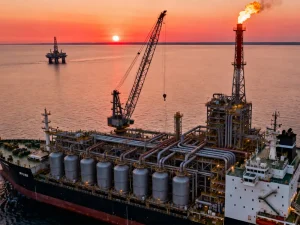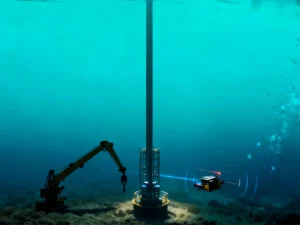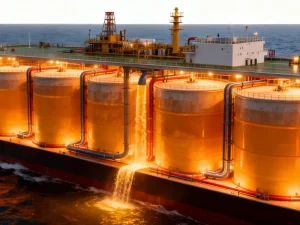Mit zunehmender Popularität steigt auch die Nachfrage nach Öl. Dort finden die Unternehmen Ölvorkommen oder -felder, die sich vom Land bis zum Meer erstrecken. Die Gewinnung von Öl aus Ölfeldern an Land ist einfacher. Bei der Förderung von Öl aus dem Meer setzen die Unternehmen jedoch FPSOs ein. Doch hier stellt sich die Frage: Was ist eine schwimmende Produktions-, Lager- und Verladeanlage (FPSO)?
FPSO ist ein großes Schiff, das wie ein großes Schiff aufgebaut ist. Es enthält jedoch die gesamte Ausrüstung, die für die Raffinierung, Lagerung und Entladung von Rohöl erforderlich ist. Der Einsatz von FPSO erleichtert die Ölförderung aus dem Meer oder Ozean. In diesem Artikel werde ich alles über FPSO erklären. Sie werden auch erfahren, wie diese FPSOs funktionieren. Also, fangen wir an!
Was ist ein FPSO?

FPSO steht für "Floating Production Storage and Offloading" (schwimmende Produktions-, Lager- und Entladungsanlage) und ist ein Schiff mit umfangreichen Öl Raffinerieanlagen. Zur Erinnerung, FPSOs unterscheiden sich von FSOs, da sie über vollständige Ölraffinerieanlagen an Bord verfügen.
Die Ölvorkommen des Feldes sind nicht auf das Land beschränkt. Es gibt viele Tiefseebohrungen oder -felder, aus denen Rohöl gewonnen werden kann. Die Unternehmen können jedoch keine speziellen Ölraffinerien an Tiefseestandorten bauen. Oder? An dieser Stelle bewähren sich FPSO-Anlagen.
Diese FPSOs (Schiffe) können auf dem Wasser schwimmen und sich von einem Ort zum anderen bewegen. Die Unternehmen nutzen sie und schicken das Rohöl zu diesen Schiffen. Das FPSO hat Raffinerieanlagen an Bord. Mit diesen Verfahren werden Verunreinigungen und Gase vom Rohöl getrennt, so dass es für die Raffination geeignet ist. Anschließend wird das raffinierte Öl in den Lagerräumen dieser FPSOs gelagert.
Diese Lagertanks sind groß genug, um große Mengen an raffiniertem Öl zu speichern. Sobald diese Tanks gefüllt sind, fährt der Shuttle-Tanker, a separates Schiff, nähert sich dem FPSO. Das Öl wird dann von der FPSO auf das nahe gelegene Shuttletankschiff entladen. Dieses Öl wird dann an Land transportiert. Ohne FPSOs wäre die Raffination, Lagerung und Entladung von Öl auf See nicht möglich gewesen.
Sind Handelsschiffe und FPSOs dasselbe? Ja, aber nein. FPSOs haben einen Rumpf und ähneln Schiffen, die zur Beförderung von Passagieren eingesetzt werden. Sie haben jedoch zusätzliche Lager- und Ölraffinerieanlagen an Bord. Durch diese zusätzlichen Einrichtungen unterscheiden sich FPSOs von normalen Schiffen. Aber auch FPSOs sind Schiffe, die über fortschrittliche Raffinerieanlagen verfügen.
Bedeutung von FPSO
Der Einsatz von FPSOs ist vor allem für die Ölförderung in tieferen Gewässern von großer Bedeutung. Ohne sie wären die Unterwasser-Ölfelder für den Menschen nutzlos gewesen. Hier sehen Sie, wie FPSO einen Mehrwert schaffen:
- Zunächst einmal ist der Einsatz von FPSOs an jedem beliebigen Ort im Meer möglich. Sie können in tiefen Gewässern eingesetzt werden, wo sich Ölfelder tief unter der Oberfläche befinden. Ohne ein FPSO wäre die Förderung aus einem solchen tiefen Ölfeld sehr schwierig gewesen.
- Wie ich bereits sagte, haben FPSOs Lagerabteile oder Tanks an Bord. In den Tanks kann das raffinierte Öl über einen längeren Zeitraum gelagert werden. Das bedeutet, dass die Unternehmen keine langen Unterwasserrohre verwenden müssen, um das Öl an Land zu transportieren.
- FPSO haben Ölraffinerie-Einheiten oder -Anlagen an Bord. Diese Anlagen trennen die Verunreinigungen - Gas und Mischwasser - vom Öl ab. Danach wird das Öl in die Lagertanks geleitet. Dadurch wird der Bedarf an zusätzlichen Raffinerien an Land verringert.
- Denken Sie daran, dass die FPSOs Schiffe sind, die schwimmen und sich auf der Wasseroberfläche bewegen können. Wenn ein Ölfeld vollständig erschöpft ist, verlagern die Unternehmen sie zu neuen Ölvorkommen oder -feldern. Das macht sie zu einer hervorragenden Investition für Ölförderunternehmen.
- Stellen Sie sich vor, Sie würden große Ölraffinerieanlagen in Gewässern bauen. Das wäre sehr kostspielig gewesen, vor allem in tiefen Gewässern. Oder? FPSOs sind billiger zu bauen und machen den Bau von Ölraffinerien an Land überflüssig. Sie gehören zu den effektivsten Methoden der Ölförderung und -raffination.
Wie funktioniert FPSO? 4 Schritte Prozess
FPSO mag komplex erscheinen, aber der Betrieb und die Funktionsweise sind relativ einfach. Im folgenden Abschnitt werde ich die Funktionsweise von FPSO in vier Schritten erklären.
1- Ölförderung aus Unterwasserbohrungen

Der Betrieb eines FPSO beginnt mit der Förderung von Rohöl. Aber woher kommt dieses Öl? Erinnern Sie sich: Rohöl und Gas befinden sich unter der Meeresoberfläche, wo es Felsen gibt. In diesen Gesteinen ist das unraffinierte Öl eingeschlossen. Die Unternehmen bohren mit hochmodernen Maschinen Löcher in die Oberfläche des Meeresbodens.
Diese kleinen Löcher sind Bohrungen, mit deren Hilfe Öl aus dem Meeresboden gefördert wird. Sobald die Bohrlöcher gebohrt sind, installieren die Unternehmen Steigleitungen (Rohre) in den Löchern. Diese Steigrohre sind direkt mit dem FPSO an der Wasseroberfläche verbunden. Einige Steigrohre sind länger, andere kürzer, je nach Wassertiefe. Diese Rohre oder Steigrohre fördern das Rohöl unter dem Gestein und leiten es zum FPSO.
2- Raffination und Abtrennung von Rohöl
Wie ich bereits sagte, besteht Rohöl aus verschiedenen Elementen. Dazu gehören Mischwasser, Gase, Sande und viele andere Verunreinigungen. Dieses Öl ist unbrauchbar; es muss raffiniert und weiterverarbeitet werden. Das FPSO verfügt über eine bordeigene Ölaufbereitungsanlage und spezielle Separatoren.
Diese Anlagen trennen das Öl von gemischten Gasen und Wasser. Im Allgemeinen werden die Gase und das Wassergemisch einfach abgelassen. Das verarbeitete und raffinierte Öl wird jedoch in Tanks oder Kammern gelagert. Einfach ausgedrückt: Ein FPSO hat eine kleine Ölraffinerie an Bord. Diese fungiert als vollwertige Verarbeitungseinheit, die Verunreinigungen entfernt und das Öl raffiniert.
3- Öllagerraum oder -tanks

Zur Erinnerung: Das FPSO hat einen Rumpf, der dem eines normalen Schiffes ähnelt. Dieser Rumpf des FPSO verfügt über Lagertanks oder Kammern. Die Lagerkapazität hängt von der Größe des FPSO ab. Nach der Verarbeitung und Raffinierung wird das Öl in die Lagertanks der FPSO geleitet.
Im Durchschnitt können FPSO-Lagertanks mehr als 2 Millionen Barrel raffiniertes Öl speichern. Wenn das FPSO jedoch alt ist, belasten die Unternehmen es nicht mit einer so großen Menge. Sie entladen das Öl aus diesen Tanks und sorgen so für eine geringere Belastung des FPSO. Moderne FPSOs bieten eine größere Lagerkapazität. Dadurch muss weniger häufig entladen werden, und das Öl kann gelagert bleiben.
4- Entladung auf Shuttle-Tanker
Der letzte Schritt im FPSO-Betrieb ist die Entladung des raffinierten Öls, das in den Lagertanks gelagert wird. Dies geschieht erst, wenn die Lagertanks 90% voll sind. Dabei wird ein separates Schiff, der Shuttletanker, eingesetzt. Dieses Shuttletankschiff fährt an den Anschlussstellen längsseits des FPSO.
Die STS-Schläuche dienen dazu, die Lagertanks der FPSO mit dem Shuttle-Tanker zu verbinden. Sobald die Verbindung hergestellt ist, pumpt das FPSO das Öl. Dadurch wird das gesamte im FPSO gelagerte Öl über Schläuche in das Shuttletankschiff umgepumpt. Dieser Öltransfer erfolgt nicht sofort und kann einige Stunden dauern, je nachdem, wie viel Öl von der FPSO entladen wird.
Sobald das gesamte Öl entladen ist, wird der Schlauch abgekoppelt, und die Shuttletanks bewegen sich in Richtung der Landanlagen. Die Lagertanks des FPSO sind bereit, das frisch raffinierte Öl aufzunehmen. Dieser Prozess hilft den Unternehmen bei der Gewinnung und Raffinierung von Öl aus Unterwasserbohrungen. Denken Sie daran, dass diese Ölentladung unter strenger Aufsicht erfolgt, um Lecks oder andere Unfälle zu vermeiden.
Schlussfolgerung
Im Allgemeinen sind die Menschen FLNG und FPSO verwechseln. Denken Sie daran, dass beide unterschiedlich funktionieren. Bei der FNLG geht es um die Gewinnung von Erdgas. Das FPSO fördert und raffiniert nur das Rohöl. Interessanterweise werden bei der FPSO sogar die Gase, die sich mit dem Rohöl vermischen, entsorgt.
Es ist bemerkenswert, dass diese Schiffe die Unterwasser-Ölförderung ermöglichen. Ohne sie könnten die Unternehmen die Ölfelder im Meer nicht nutzen. Warum eigentlich? Der Grund ist, dass der Bau von Ölraffinerien an der Meeresoberfläche sehr kostspielig und schwierig ist. In diesem Artikel habe ich alles über FPSOs und ihre grundlegende Funktionsweise erläutert.
